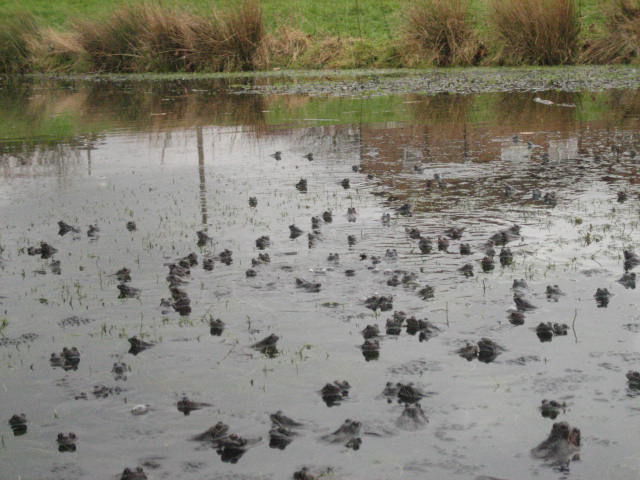Big Spawn Count
5th February 2015
We have opened up our annual amphibian survey for the new breeding season.
The days are getting noticeably longer, and the frogs and toads are taking their cue. Soon, ponds across the country will be a bubbling bath of croaking frogs. The spawn they lay is a cheery sight for anyone looking for signs of life returning, but it is also a measure of the local frog population, and can tell us something about ponds.
 Hundreds of Common Frogs gather in a pond in Lancashire to breed.
Hundreds of Common Frogs gather in a pond in Lancashire to breed.
Each spring we run the Big Spawn Count, with partners ARG UK and Amphibian and Reptile Conservation, and ask you to report the total amount of spawn you see in garden ponds and other water bodies. Along with some additional details about the pond, we can use the information to learn more about what makes a pond good for amphibians, and offer you improved, evidence-based information about making wildlife ponds through our Advice Centre.
The results of Big Spawn Count 2014 have been analysed. Around 600 people sent information on the frogs spawning in their gardens. Spawning peaked earlier than in the very cold 2013. Encouragingly, the spawn timings shown by Big Spawn Count are very similar to those collected in the Woodland Trust’s Nature’s Calendar project.
As in previous years, most people recorded up to 20 spawn clumps but a lucky few hit the jackpot with a lot more than this – in a handful of ponds more than 100 clumps. This pattern looks pretty consistent between years.
It’s not very surprising to find that if you have a small pond (1 m x 1 m) you don’t get very large amounts of spawn. But you don’t need a huge pond to substantially increase the number of frogs coming to spawn; there’s a suggestion that once your pond is what we called ‘medium sized’ (up to 5 m x 5 m) increasing the pond’s size doesn’t make much difference to the amount of spawn deposited even if you make the pond substantially bigger.
The survey also gives us some insights into the vexed question of fish. On small and medium sized ponds, frogs do not seem to be deterred from spawning by the presence of fish. Of course the tadpoles may not fare very well, but quite a few people do have frogs coming back to ponds that also have fish. So unless these fish ponds are entirely populated by young frogs colonising from different ponds, it looks as though tadpoles are surviving with fish at least some of the time. But it’s clear that if you want a lot of frog spawn, you’re more likely to succeed without fish: of the 20 ponds that were recorded which had 50 or more clumps of spawn, three quarters had no fish.
Now you can take part in the Big Spawn Count 2015 and help us learn more about how ponds work. When the frogs have laid spawn in you pond, count the clumps and fill in the simple Big Spawn Count form.
